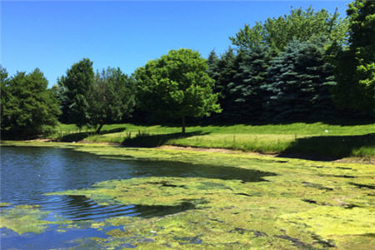Wastewater Nitrogen Is Causing Ecological Havoc, But The Necessary Innovative Solutions Exist
By Pio Lombardo, PE

The water quality damages associated with excessive nitrogen discharges to our surface and groundwaters that result in life-threatening harmful algae blooms (HAB), the loss of shellfish and finfish, and the degradation of our groundwater drinking water aquifers are now ubiquitous in the U.S. and worldwide. Wastewater nitrogen discharges are typically the elephant in the room when the sources of nitrogen are quantified. Septic nitrogen discharges, in particular, are the primary cause of water-quality/ecological degradation in many, especially coastal, areas.
Cape Cod, Martha’s Vineyard, New Hampshire’s Great Bay, Connecticut coastal communities, Long Island, Florida, and numerous aquifers in the western U.S. have exhibited this wastewater nitrogen destruction of aquatic resources with significant adverse impacts. The damage is widespread in Florida, where springs and rivers are no longer viable for recreational and aquatic resources. The Conservation Law Foundation, who were instrumental in the Boston Harbor cleanup, announced it plans to sue Cape Cod towns to get the septic nitrogen issue addressed, and “demands a temporary suspension of any new septic systems and system inspections that support sales of properties that use septic on Cape Cod until this widespread problem can be fixed.”
Development can provide leadership in addressing this wastewater nitrogen challenge. As climate change concerns stimulated the use of ‘zero energy’ (or even ‘positive energy’) buildings, development can provide zero, as well as positive, nitrogen impact. The tools exist and are cost-effective to achieve this objective. Conventional sewering is not cost-effective nor technically capable to achieve the required nitrogen removal requirements. Distributed (i.e., onsite and neighborhood/cluster) wastewater systems, along with innovative groundwater treatment systems using permeable reactive barriers (PRB), have demonstrated cost-effectiveness, technical reliability, and the ability to achieve net positive nitrogen impact for the past 20 years throughout the U.S.
As a point of reference, the state-of-the-art capability for sophisticated centralized wastewater treatment systems is to produce treated water with total nitrogen (TN) of 3 mg/L. On-site wastewater systems achieving effluent TN < 5 mg/L have been permitted since 2001, with numerous installations throughout the U.S. The U.S. EPA’s LaPine, OR, demonstration project in 2001 validated that on-site systems can achieve effluent TN of 2.2 mg/L with no maintenance. These systems have been vetted by numerous federal, state, and county independent evaluations during the past 20 years, demonstrating the ability to achieve an average TN of 3 mg/L. Neighborhood/cluster wastewater systems have demonstrated the ability to reliably achieve effluent TN of < 2 mg/L. One was recently permitted by the state of Utah for a hotel next to a national park, with the requirement to achieve TN < 2.5 mg/L.
PRBs are a groundwater treatment technique in which the treatment system is placed in groundwater and nitrogen is removed from groundwater as the water naturally flows through the PRB. In 2005, a PRB was installed on Cape Cod and documented by a Woods Hole academic institution to be effective at nitrogen removal. For a new development, a PRB has been installed in Southampton, NY, that along with a neighborhood wastewater system will remove more nitrogen than the project would discharge, achieving net-positive nitrogen impact. This is achieved as the PRB will also remove groundwater nitrogen from other sites that discharge to groundwater. An attractive feature of a PRB technique is that it is a passive treatment system and will have a useful life of 40-plus years. Beyond nitrogen-removal performance monitoring, there is no required O&M. In Connecticut, a state-permitted PRB was paired with a conventional treatment system to achieve 97 percent nitrogen removal and avoided the need for a wastewater treatment system and additional O&M.
While the above speaks to the water quality impact of wastewater nitrogen, the drinking water impact can be significant in areas that rely upon groundwater for their water supply. The drinking water public health standard require that nitrate-nitrogen be < 10 mg/L. Many permits for wastewater systems that discharge into drinking water aquifers require effluent TN to be less than 10 mg/L. As a safety precaution, some areas require effluent TN < 5 mg/L. In some western arid areas, the effluent TN requirement is < 2.5 mg/L.
For many areas, connecting to a sewer system for development or to address nitrogen contamination is not a viable option. However, there are many opportunities for innovation to address wastewater nitrogen that can produce win-win situations for property owners and the environment. Development can provide leadership in demonstrating how to achieve positive nitrogen impact outcomes — and in many areas, demonstrating this leadership will be a requirement for project approvals.
 Pio Lombardo, PE, is president of Lombardo Associates, Inc., a Boston-based, national, 45-year-old environmental engineering firm responsible for more than $300 million of innovative, award-winning municipal and private wastewater and water supply projects.
Pio Lombardo, PE, is president of Lombardo Associates, Inc., a Boston-based, national, 45-year-old environmental engineering firm responsible for more than $300 million of innovative, award-winning municipal and private wastewater and water supply projects.
